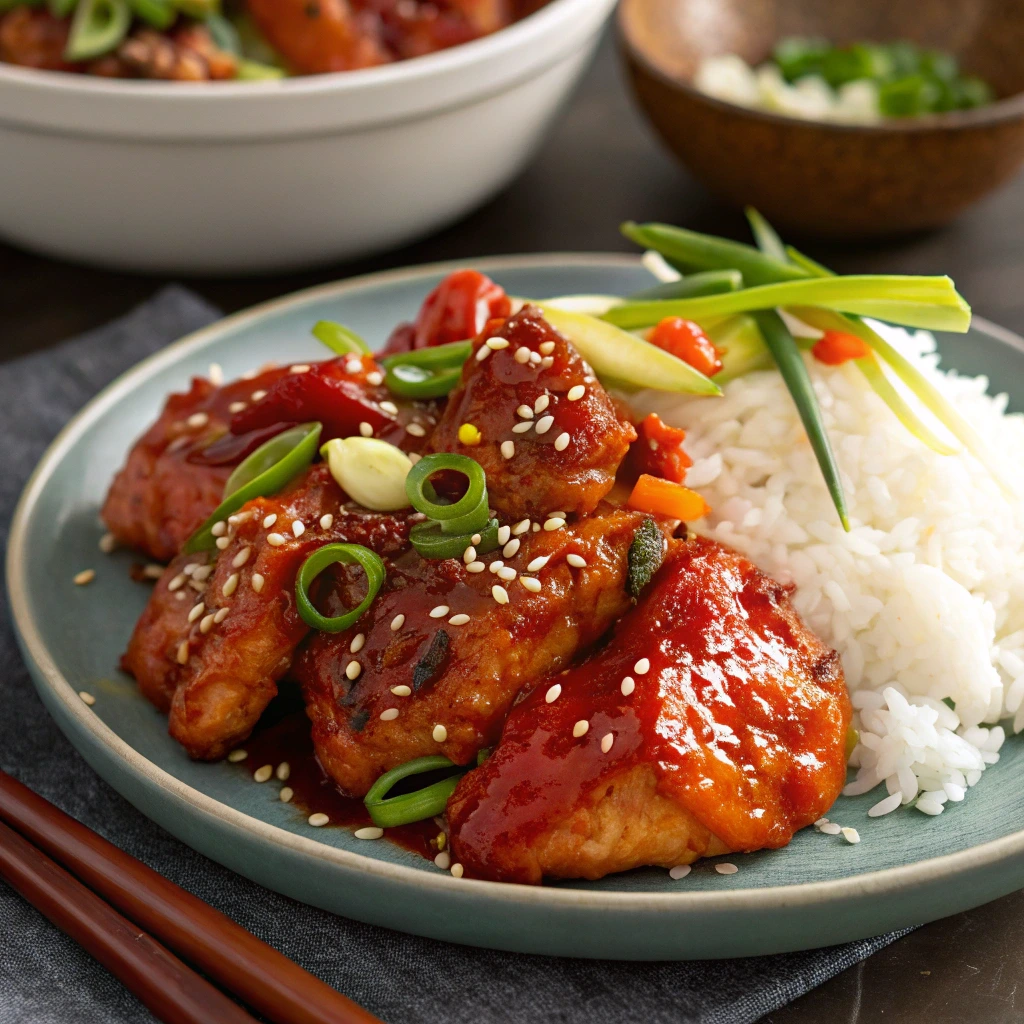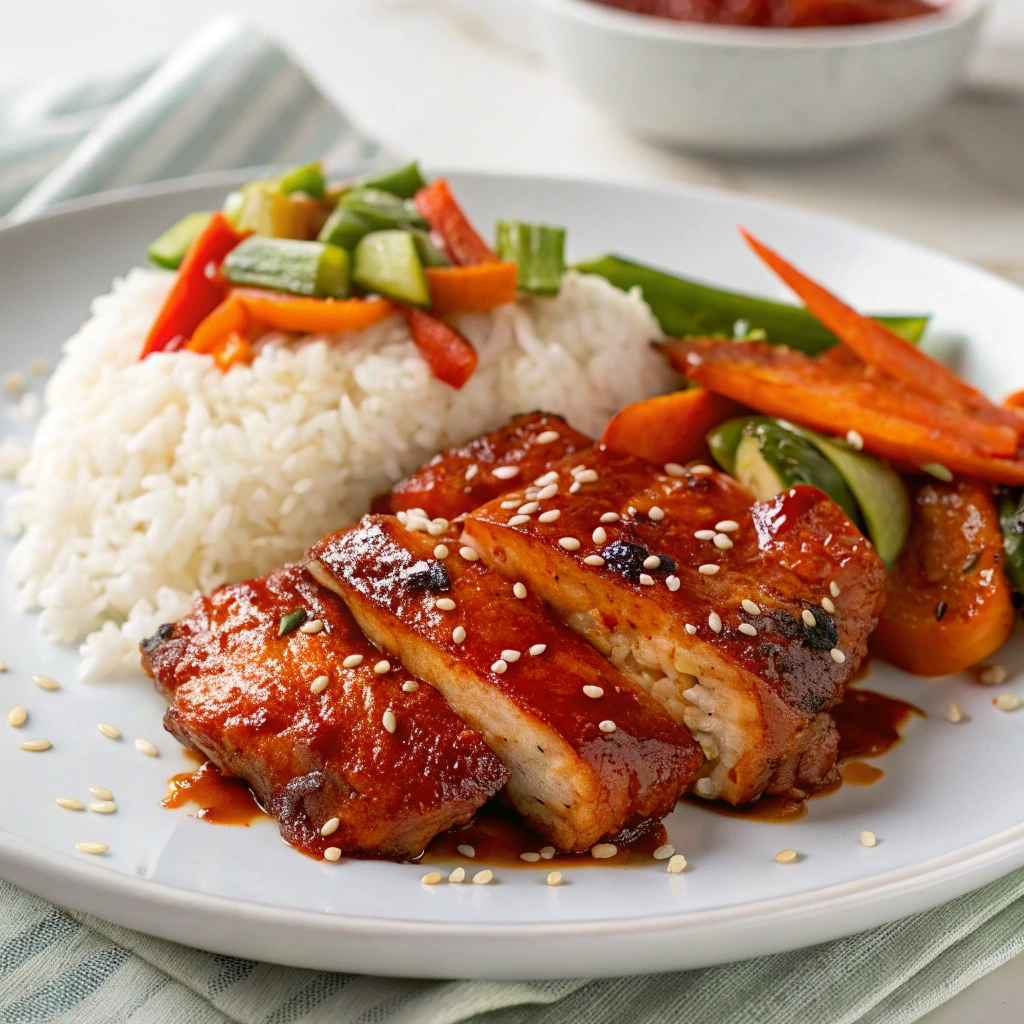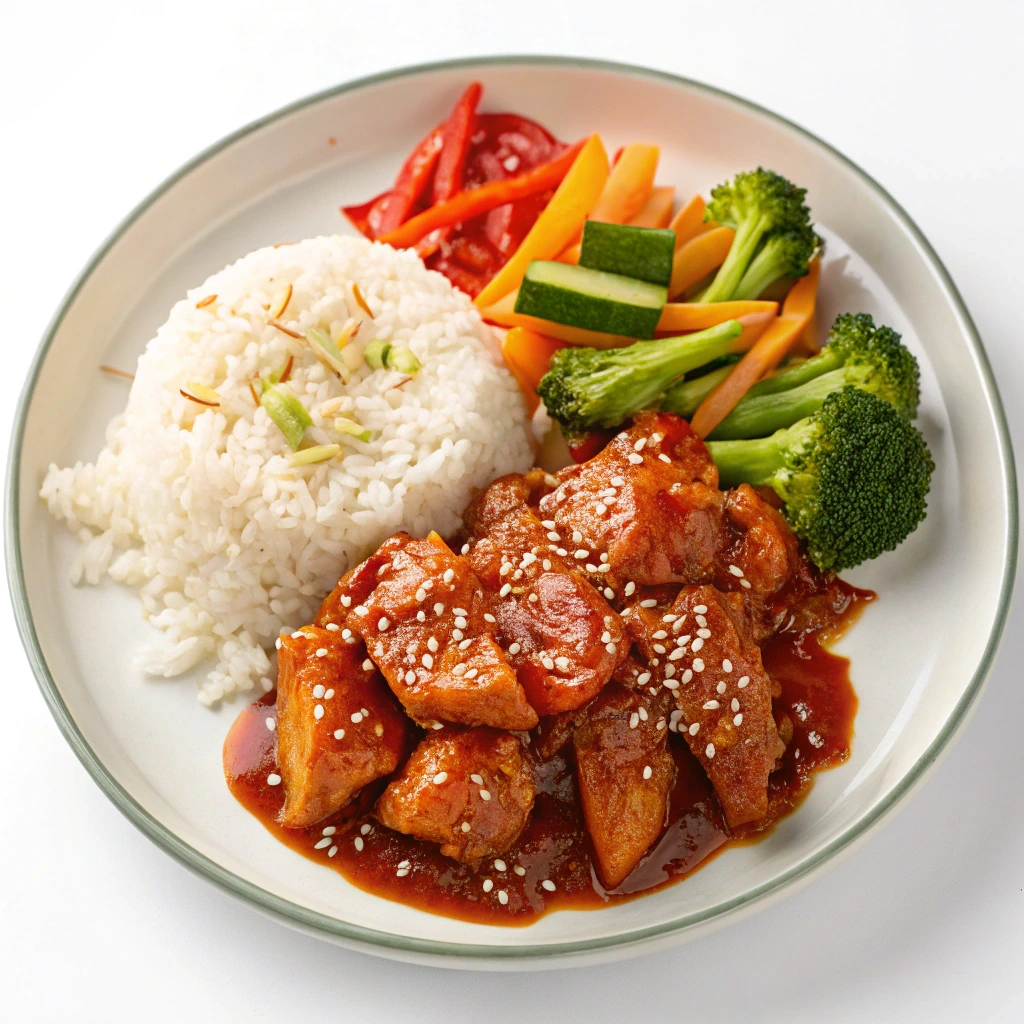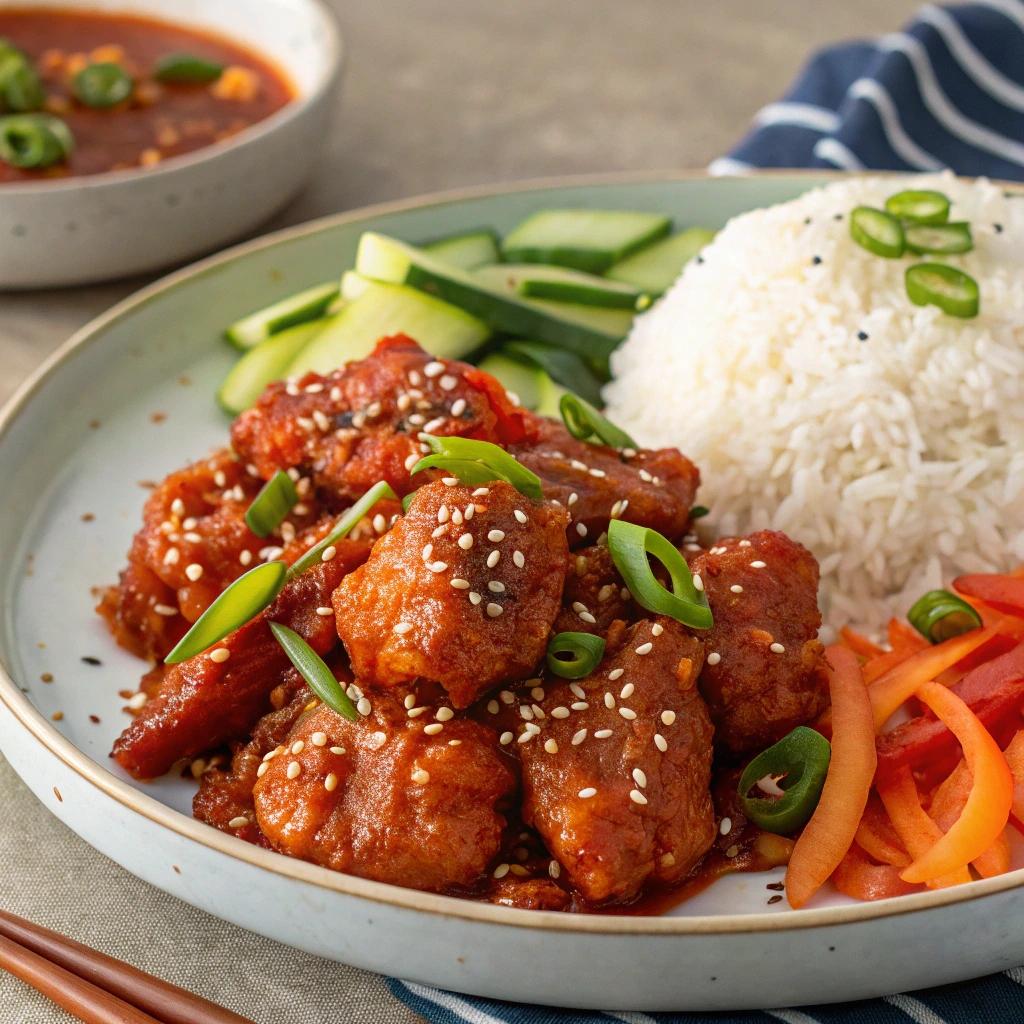
Introduction
There’s something magical about the first bite of gochujang chicken—its sticky, spicy-sweet glaze coating tender chicken pieces in a symphony of flavors. If you’ve ever craved that irresistible taste but thought it was only possible at your favorite Korean restaurant, think again! Making gochujang chicken at home is easier than you might imagine, and the results can be just as satisfying—if not better.
Let me share a personal story: The first time I tried gochujang chicken, I was blown away by how simple ingredients could create such complexity. It wasn’t until later that I realized I could replicate this dish in my own kitchen with minimal effort. Now, whenever I want a comforting yet exciting meal, gochujang chicken is always on the menu. Let’s dive into everything you need to know to master this dish.
What Is Gochujang Chicken?
Gochujang chicken is a vibrant Korean dish where juicy chicken pieces are marinated and cooked in a rich sauce made from gochujang paste—a fermented chili paste that brings heat, depth, and umami to the table. This dish has become increasingly popular because of its bold flavors and ease of preparation.
Key Ingredients for Gochujang Chicken
- Main Protein: Chicken thighs or breasts (both work, though thighs tend to stay juicier).
- Gochujang Paste: A staple in Korean cooking, known for its fiery kick and sweetness.
- Soy Sauce: Adds saltiness and enhances the umami flavor.
- Sweeteners: Honey or brown sugar balances out the spiciness.
- Aromatics: Garlic and ginger give the dish an aromatic base.
The Role of Gochujang Paste in Korean Cuisine
Gochujang is more than just a spice—it’s a cultural cornerstone in Korean cooking. Its versatility makes it ideal for marinades, soups, stews, and even dipping sauces. When used in chicken recipes, it creates layers of flavor that leave your taste buds tingling.
Why People Love Gochujang Chicken
It’s all about balance. Sweet, spicy, savory, and tangy notes come together seamlessly in every bite. Plus, it’s adaptable—you can adjust the level of spiciness to suit your palate.
Ingredients You’ll Need
Before we get started, let’s gather our tools and pantry staples. Having everything ready will make the process smoother and ensure success.
Main Protein Options
- Chicken Thighs: These are preferred for their tenderness and moisture retention. They also absorb marinades beautifully.
- Chicken Breasts: A leaner option if you’re watching calories, though they may dry out faster during cooking.
Essential Pantry Staples
Here’s what you’ll need to whip up this dish:
| Ingredient | Quantity | Notes |
|---|---|---|
| Gochujang Paste | 2–3 tablespoons | Adjust based on desired spiciness |
| Soy Sauce | 2 tablespoons | Low-sodium works well |
| Rice Vinegar | 1 tablespoon | For acidity |
| Sesame Oil | 1 teaspoon | Adds richness |
Flavor Enhancers
These aromatics take your dish to the next level:
- Fresh garlic (minced)
- Grated ginger
- Finely chopped green onions
Optional Add-Ins
For extra flair:
- Brown sugar or honey
- Chili flakes for added heat

Step-by-Step Instructions
Now that you have your ingredients, let’s walk through the steps to create tender and spicy gochujang chicken.
Preparing the Marinade
Combine the following in a mixing bowl:
- Gochujang paste
- Soy sauce
- Rice vinegar
- Sesame oil
- Minced garlic and grated ginger
- Sweetener of choice (honey or brown sugar)
Whisk thoroughly until smooth. Taste and adjust seasoning as needed.
Marinating the Chicken
- Place your chicken pieces in a large resealable bag or shallow dish.
- Pour the marinade over the chicken, ensuring each piece is coated evenly.
- Marinate for at least 1 hour (or overnight for deeper flavor).
Cooking Methods
Choose between these two popular methods:
- Pan-Searing: Heat a skillet over medium-high heat. Cook the chicken until golden brown and fully cooked through.
- Pro Tip: Reserve some marinade for glazing later.
- Baking: Preheat your oven to 400°F (200°C). Arrange chicken on a baking sheet lined with parchment paper. Bake for 20–25 minutes, flipping halfway through.
Finishing Touches
- Brush reserved marinade onto the chicken during the last few minutes of cooking for a glossy finish.
- Garnish with sliced green onions and toasted sesame seeds for presentation.
Tips for Making Perfect Gochujang Chicken
To elevate your dish further, follow these expert tips:
Achieving Tender Chicken Every Time
- Use boneless, skinless chicken thighs for maximum tenderness.
- Consider brining the chicken beforehand to lock in moisture.
Adjusting Spiciness Levels
- Start with less gochujang and gradually increase according to your tolerance.
- Add chili flakes for an extra burst of heat.
Preventing the Sauce from Burning
- Keep the heat moderate when reducing the marinade. Stir frequently to avoid sticking.
Storing Leftovers Properly
- Store cooked chicken in an airtight container in the refrigerator for up to 3 days. Freeze portions for longer storage.
Serving Suggestions and Pairings
Once your gochujang chicken is ready, it’s time to decide how to serve it. Here are some ideas:
Classic Side Dishes
Pair your chicken with traditional Korean sides:
- Steamed white rice
- Kimchi (spicy fermented cabbage)
- Pickled radishes or cucumbers
Alternative Serving Ideas
Get creative with these options:
- Wrap the chicken in lettuce leaves for a fresh twist.
- Add it to tacos or burritos for a fusion-style meal.
Drinks That Pair Well with Spicy Food
Cool down the heat with beverages like:
- Cold beer or soju
- Milk or yogurt-based drinks
Dessert Options for Balance
Finish your meal with light desserts:
- Fruit salad
- Yogurt parfait
What Is Gochujang Chicken? (Expanded)
Gochujang chicken is more than just a dish—it’s an exploration of Korean culinary traditions brought to life in your kitchen. This recipe combines tender chicken pieces with a marinade that highlights gochujang paste, soy sauce, honey, garlic, and ginger. The result? A sticky, spicy-sweet glaze that coats every bite perfectly.
The Science Behind Gochujang Paste
Gochujang is made from red chili peppers, fermented soybeans, glutinous rice, and salt. Its fermentation process gives it a complex flavor profile: sweet, spicy, savory, and slightly tangy. To dive deeper into the history and production of this incredible ingredient, check out this detailed article on gochujang to learn more about its cultural significance and traditional manufacturing methods.
Did You Know?
Gochujang has been used in Korean cooking for centuries and is considered one of the “Three Treasures” of Korean cuisine alongside doenjang (soybean paste) and ganjang (soy sauce).
Why Gochujang Chicken Stands Out
Here are three reasons why this dish has become a global favorite:
- Balanced Flavors: Sweetness from honey or brown sugar offsets the spiciness of gochujang, creating harmony.
- Versatility: Whether you prefer boneless thighs or crispy wings, gochujang chicken adapts effortlessly.
- Ease of Preparation: With simple steps and readily available ingredients, anyone can make this dish at home.

Ingredients You’ll Need (Expanded)
To achieve the best results, pay attention to ingredient quality and preparation techniques. Below is a detailed breakdown of what you need.
Main Protein Options
While both chicken thighs and breasts work well, here’s why thighs might be the better choice:
- Moisture Retention: Boneless, skinless chicken thighs stay juicier during cooking.
- Flavor Absorption: Their higher fat content helps them soak up marinades more effectively.
If using chicken breasts, consider slicing them into smaller pieces to speed up cooking and prevent dryness.
Essential Pantry Staples
Let’s explore these core ingredients in greater detail:
| Ingredient | Role | Tips for Best Results |
|---|---|---|
| Gochujang Paste | Provides heat, sweetness, and umami | Look for high-quality brands like Chung Jung One or Sunchang. |
| Soy Sauce | Adds saltiness and enhances umami | Opt for reduced-sodium versions if health-conscious. |
| Rice Vinegar | Balances acidity | Use white rice vinegar for clarity. |
| Sesame Oil | Contributes richness and aroma | Toasted sesame oil offers deeper flavor. |
Flavor Enhancers
These aromatics transform ordinary chicken into something extraordinary:
- Garlic: Minced fresh garlic adds sharpness without overpowering the dish.
- Ginger: Grated ginger brings warmth and complements the spiciness of gochujang.
- Green Onions: Chopped green onions add freshness and visual appeal when garnishing.
Optional Add-Ins
Take your recipe to the next level with these extras:
- Brown Sugar: For caramelization and added sweetness.
- Chili Flakes: Increase spiciness while adding texture.
- Korean Pear: Shredded pear acts as a natural tenderizer and sweetener.
Step-by-Step Instructions (Expanded)
Now that we’ve covered the ingredients, let’s delve deeper into the cooking process.
Preparing the Marinade
Creating the perfect marinade involves precise measurements and thorough mixing. Follow these steps:
- In a large bowl, whisk together gochujang paste, soy sauce, rice vinegar, sesame oil, minced garlic, grated ginger, and your chosen sweetener.
- Taste the marinade and adjust seasoning as needed. Remember, you can always add more spice or sweetness later.
Pro Tip:
Reserve about ¼ cup of the marinade separately before adding it to the chicken. This reserved portion will be used for glazing later.
Marinating the Chicken
Proper marination ensures maximum flavor absorption:
- Place the chicken pieces in a resealable plastic bag or shallow dish.
- Pour the marinade over the chicken, ensuring all pieces are evenly coated. Seal the bag and massage gently to distribute the marinade.
- Refrigerate for at least 1 hour or up to overnight for deeper flavor penetration.
Storage Tip:
If marinating overnight, flip the bag halfway through to ensure even coverage.
Cooking Methods
Both pan-searing and baking yield delicious results, but they differ slightly in technique:
Pan-Searing Method
- Heat a non-stick skillet over medium-high heat. Add a splash of oil to prevent sticking.
- Remove the chicken from the marinade, letting excess drip off. Reserve the remaining marinade for later use.
- Cook the chicken in batches to avoid overcrowding the pan. Sear each side for 5–7 minutes until golden brown and fully cooked.
Baking Method
- Preheat your oven to 400°F (200°C). Line a baking sheet with parchment paper for easy cleanup.
- Arrange the chicken pieces in a single layer, leaving space between them for even cooking.
- Bake for 20–25 minutes, flipping halfway through to ensure even browning.
Finishing Touches
For that restaurant-style glossy finish:
- Brush the reserved marinade onto the chicken during the last few minutes of cooking. Be careful not to burn the sauce.
- Garnish generously with sliced green onions and toasted sesame seeds.
Tips for Making Perfect Gochujang Chicken (Expanded)
Achieving perfection requires attention to detail. Below are advanced tips to refine your technique.
Achieving Tender Chicken Every Time
Tenderness depends on protein selection and preparation methods:
- Brining: Soak chicken in a saltwater solution for 30 minutes to enhance moisture retention.
- Pounding: Flatten chicken pieces slightly to ensure even cooking.
- Resting: Allow cooked chicken to rest for 5 minutes before serving to redistribute juices.
Adjusting Spiciness Levels
Not everyone loves extreme heat. Customize the spiciness by:
- Using less gochujang paste initially and adjusting gradually.
- Adding chili flakes or sriracha for extra kick.
- Incorporating dairy-based sides like yogurt or cheese to balance the heat.
Preventing the Sauce from Burning
Burnt sauce ruins the dish. Prevent this by:
- Keeping the heat moderate when reducing the marinade.
- Stirring frequently to prevent sticking.
- Diluting the marinade slightly with water if it thickens too quickly.
Storing Leftovers Properly
Leftover gochujang chicken reheats beautifully. Store it:
- In an airtight container in the refrigerator for up to 3 days.
- In freezer-safe bags for long-term storage. Reheat in the oven or microwave for optimal texture.
Serving Suggestions and Pairings (Expanded)
Presentation matters just as much as taste. Here’s how to serve gochujang chicken creatively.
Classic Side Dishes
Traditional accompaniments highlight the dish’s Korean roots:
- Steamed Rice: Absorbs the flavorful juices.
- Kimchi: Adds crunch and tanginess.
- Pickled Vegetables: Offers refreshing contrast.
Alternative Serving Ideas
Experiment with fusion concepts:
- Wrap chicken in lettuce leaves for a low-carb option.
- Stuff it into tacos or burritos for a Mexican twist.
- Serve atop noodles or salads for variety.
Drinks That Pair Well with Spicy Food
Combat the heat with refreshing beverages:
- Soju: A classic Korean spirit that complements the meal.
- Milk: Neutralizes capsaicin, the compound responsible for spiciness.
Dessert Options for Balance
End your meal on a sweet note:
- Fruit Salad: Light and refreshing.
- Yogurt Parfait: Layered with granola and berries.
- Ice Cream: Vanilla or mango flavors work exceptionally well.

Conclusion
Gochujang chicken represents the essence of Korean cuisine—bold, balanced, and deeply satisfying. By following this guide, you now possess the knowledge and skills to recreate this dish confidently at home. Whether you’re hosting friends or enjoying a quiet night alone, gochujang chicken promises to delight your senses.
Don’t shy away from experimentation. Try substituting ingredients, altering cooking methods, or pairing it with unconventional sides. After all, cooking is an art form, and your creativity knows no bounds. Share your creations with us—we’d love to see your unique take on this timeless recipe!
FAQ Section
Q: What is gochujang chicken?
A: Gochujang chicken is a Korean dish where chicken pieces are marinated and cooked in a spicy-sweet sauce featuring gochujang paste. It’s renowned for its rich, balanced flavors.
Q: Can I freeze gochujang chicken?
A: Absolutely! Store portions in freezer-safe containers or bags for up to 3 months. Thaw overnight in the refrigerator before reheating.
Q: How do I know if my chicken is fully cooked?
A: Use a meat thermometer to check internal temperature. Chicken should reach 165°F (74°C) for safe consumption.
Q: Can I substitute gochujang paste with something else?
A: While nothing replicates gochujang entirely, you can approximate its flavor using a mix of chili paste, tomato paste, and brown sugar. However, authentic gochujang delivers unmatched depth.
